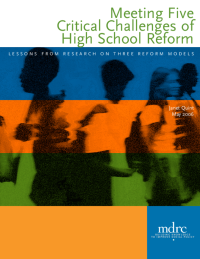Meeting Five Critical Challenges of High School Reform
Lessons from Research on Three Reform Models
High school reform has moved to the top of the education policy agenda, commanding the attention of the federal government, governors, urban school superintendents, philanthropists, and the general public. All are alarmed by stubbornly high dropout rates and by the low academic achievement of many high school students. These problems disproportionately affect disadvantaged young people, especially those who are African-American and Hispanic and who attend urban schools and certain rural schools in the South and Southwest.
This is the first in a series of reports for policymakers, practitioners, and others who must make hard choices about how to change high schools. It discusses three comprehensive initiatives evaluated by MDRC — Career Academies, First Things First, and Talent Development — that have grappled with the challenges of improving low-performing urban and rural schools. Together, these three interventions are being implemented in more than 2,500 high schools across the country, and various components of these models are being used in thousands more schools.
MDRC’s evaluations of these programs provide unusually strong evidence about each intervention’s effects. For districts and schools interested in replicating a comprehensive school reform and benefiting from the potential synergies of components that program developers designed as an integrated package, turning to one of MDRC’s reports on these models would be a good first step. This report takes a different path, however. It offers research-based lessons from across these evaluations about five major challenges associated with low-performing high schools: (1) creating a personalized and orderly learning environment, (2) assisting students who enter high school with poor academic skills, (3) improving instructional content and practice, (4) preparing students for the world beyond high school, and (5) stimulating change in overstressed high schools.
The overall message of this synthesis is that structural changes to improve personalization and instructional improvement are the twin pillars of high school reform. Small learning communities and faculty advisory systems can increase students’ feelings of connectedness to their teachers. Especially in interaction with one another, extended class periods, special catch-up courses, high-quality curricula, training on these curricula, and efforts to create professional learning communities can improve student achievement. School-employer partnerships that involve career awareness activities and work internships can help students attain higher earnings after high school. Furthermore, students who enter ninth grade facing substantial academic deficits can make good progress if initiatives single them out for special support. These supports include caring teachers and special courses designed to help entering ninth-graders acquire the content knowledge and learning skills that they missed out on in earlier grades.
Whether districts and schools adopt a comprehensive reform initiative like the ones MDRC studied or put together the elements of a comprehensive intervention on their own, much has been learned about what is needed — and what seems to work. What remains is to make sure that practitioners have the support they need to put that learning into practice.






